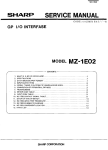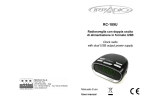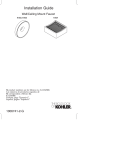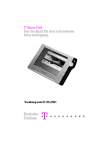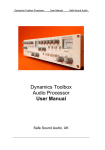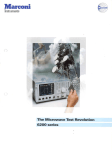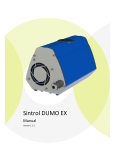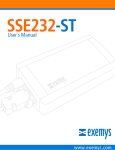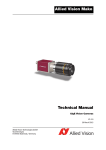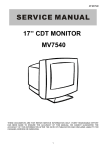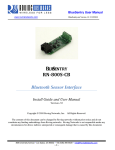Download 10 kHz to 1 GHz AM/FM Signal Generators 2022A&C
Transcript
®
E stablished 1981
Advanced Test Equipment Rentals
www.atecorp.com 800-404-ATEC (2832)
10 kHz to 1 GHz AM/FM
Signal Generators
2022A&C
C Wide frequency cover :
10 kHz to 1000 MHz
C Comprehensive amplitude, frequency and phase
modulation
C +13 dBm output (2022C)
El Simple operation
Small, light and rugged for portability
CG
Non-volatile memory with 100 settings
Powerful second functions for rapid fault finding
and calibration
2022A and 2022C Signal Generators are compact,
lightweight units offering frequency, phase and
amplitude modulation over the frequency range 10 kHz
to 1 GHz . Output levels up to + 13 dBm are offered on
the 2022C and +6 dBm on the 2022A . The units are
designed for a wide range of applications in research
development,
production and
maintenance .
Microprocessor control provides simple and rapid
operation by direct keyboard entry of settings and the
non-volatile memory, which can store up to one hundred
settings, further reduces measurement time . Full GPIB
programmability adds greater flexibility and faster
throughput in systems applications .
O Reverse power protection up to 50 W
F Choice of output calibration units
CI Optional GPIB programmability
Operation
A simple keyboard layout ensures easy operation . All
parameters are set using the numeric keys, while up
and down keys allow the values to be varied in steps
of any size . A TOTAL SHIFT key displays the deviation
from the original setting and a RETURN key returns the
selected parameter to the original value . All front-panel
functions are available from GPIB when the optional
GPIB interface board is fitted .
Frequency, phase and amplitude modulation are
selected by operation of the appropriate key, and for
rapid measurements of receiver signal-to-noise ratio
2022A &C
the modulation can be switched on and off using the
MOD ON-OFF key .
Provision is made for operation with an external
reference frequency of 1 MHz or 10 MHz as required .
Display
Measurement settings are indicated on a large liquid
crystal display, offering clarity and low power consumption . The display features 7-digit resolution for carrier
frequency, 3 digits for modulation and 4 for r .f . level,
with units annunciators for unambiguous reading . Status
and diagnostic information are also shown . Carrier
frequency, modulation and r .f . level are all shown
together .
Output
RF output levels up to + 13 dBm can be set on the 2022C
(up to -+ 6 dbm on 2022A) in all modulation modes by
direct keyboard entry or via the GPIB with a resolution
of at least 0 . 1 dB over the entire range . Total level
accuracy is + 1 dB for output levels above - 10 dBm
and ±2 dB below - 10 dBm . Levels are indicated on a
four-digit liquid crystal display with units annunciators
and levels can be incremented in steps of any size .
A choice of seven calibration units is available to the
operator and provision is made for the simple conversion
of units (e .g . dBm to pV) . Calibration data for the output
level is held in the memory and may be altered from
the front panel or over the interface bus .
The output level can be offset by up to ± 2 dB from
the calibrated value to compensate for cable or switching
losses external to the generator . The operator may also
use this facility as a means of deliberately offsetting the
output level to ensure that all generators in an area
give identical measurements . While using the offsetting
facility the main calibration of the generator is not lost
and may be returned to at any time .
when the input level is outside the range of the a .l .c .
system .
2022C is fitted with a rear panel auxiliary modulation
input socket which allows an external modulation signal
(e .g . a sub-audible signalling tone) to be mixed with the
internal signal .
Incrementing
All parameters can be incremented or decremented in
steps of any size, which may be simply entered via the
keyboard or GPIB . If no step size is entered for a
parameter the steps are pre-set to 1 kHz for carrier
frequency, 1 kHz for f .m . deviation, 1 radian for o .m.
deviation, 1% for a .m . depth and 1 dB for output level .
A single tap on either the UP or DOWN key moves
the parameter by one step . If the key is held down the
parameter steps once, waits one second and then moves
at three steps per second . For search purposes it is
possible to reverse this stepping direction without the
one second delay .
Operation of the TOTAL SHIFT key displays the variations in all parameters from their original settings . Use
of the RETURN key sets the selected parameter back to
its start value .
Non-volatile memory
The inclusion of a true non-volatile semiconductor
memory for storage of up to twenty complete generator
settings and a further eighty carrier frequencies ensures
that settings are retained even when the generator is
switched off, without relying on a battery . Any of the
sets of data can be instantly recalled when required for
later use and the UP/DOWN keys may be used to step
through a sequence of tests . A further feature enables
a single group of preset measurement values to be
recalled automatically at switch-on .
In addition to storage and recall of measurement
settings, non-volatile memory contains other useful data .
Reverse power protection
Calibration data - on r .f . level, f .m . accuracy and r.f .
An electronic trip protects the generator output against
calibration units-are retained in these stores and may
reverse power of up to 50 W, preventing damage to
be altered using protected Second Functions . Output
output circuits when RF or DC power is accidentally
level offset values are also retained in the instrument's
applied . This feature contributes to long unit life and
memories and may be selected or deselected by Second
low cost-of-ownership .
Function operation .
Status information stored includes : internal/external
Modulation
standard ; GPIB address ; type and serial number . ElapComprehensive a .m ., f .m . and .u.m, facilities are pro- sed time indicators are also accessed via the internal
vided for testing all types of receivers . A MOD ON-OFF memories . One stores the number of operational hours
key is fitted to allow signal-to-noise ratio checks to be
since the instrument was manufactured and cannot be
made .
altered . The other records the number of elapsed hours
The wide range frequency modulation facility provides
since the clock was last reset ; re-settings being accomf .m . deviation up to a maximum of 99 .9 kHz depending plished using a secure Second Function .
on modulation and carrier frequency, and excellent f .m .
In GPIB operation the non-volatile memory may be
accuracy is assured by the storage of calibration values . used to store a user-defined string . Up to 32 ASCII
in the memory . Phase modulation is available with a
characters may be written to, or read from the unit, for
deviation range of up to 9 .99 radians and amplitude example to record the instrument's inventory informamodulation is provided with steps of 0 . 5% up to 99°5% tion, date of last calibration, normal instrument location
depth .
etc .
External modulation is possible with a wide band
input of 50 Hz to 100 kHz for f .m ., 50 Hz to 10 kHz for Programming
o.m . and 20 Hz to 50 kHz (d .c, coupled) for a .m . The 2022A and 2022C can be simply fitted at any time with
characteristics of the f .m . input allow the digital signals the optional GPIB interface so that all functions can be
commonly used in mobile radio to be handled . A controlled over the bus . The instruments function as
talker as well as listener . In the listen mode the genermodulation levelling function is included which can be
ator's functions are set by simple instructions, and in
disabled when not required . HI and LO indications show
2022A&C
1 GHz
Onset torn corner !'Hzl
Typical SSB phase
rose o120224 Signal Generator
the talk mode strings of information containing details
of the instrument's settings can be sent back over the
bus, allowing the controller to learn settings for later
use .
Ease
of programming is ensured by careful
selection of mnemonics . For example to send a carrier
frequency of 123 . 456 MHz, an f .m . deviation of 3 . 5 kHz
and an output level of 1 . 74 pV, and to place these
settings in store 10 of the memory, it is only
necessary to send over the bus the instruction
CF123 .456MZ,FM3 .5KZ,LV1 .74UV,ST10 . The use of commas as delimiters in the instruction string is not essential
but often aids interpretation of program lines .
Service requests (SRQs) are sent for a variety of
reasons including reverse power protection tripped and
illegal characters received . SRQs may be inhibited if
desired by setting flags in the generator using a Second
Function .
Second Functions
The front panel Second Function key gives access to a
number of different features available with 2022A and
2022C . Some of these are related to maintenance,
calibration and programmable operation via GPIB . To
prevent accidental interference with the contents of
internal memories, those Second Functions that enable
the internal data to be altered are protected by a secure
key sequence .
Two levels of protection are offered, appropriate to
the Second Function being accessed . The most secure is
reserved for Second Functions that alter the instrument's
GENERAL DESCRIPTION
2022A and 2022C are synthesized signal
generators covering the frequency range
10 kHz to 1 GHz The output may be
amplitude . phase or frequency modulated
Using either the built-in a I source or an
external signal All control settings are
entered from a iron` panel keyboard A
single liquid crystal display gives
simultaneous readout of frequency,
modulation and output level . Remote
control via the General Purpose Interlace
Bus is available as an option .
CARRIER FREQUENCY
calibration data, change its identity string, protect its
store settings or blank the displays when memories are
recalled . Less severe is the first level of protection,
which enables the user to access those Second
Functions that do not affect the fundamental calibration,
but which may be relevant to normal operation . Examples include the selection of : r .f . level calibration units,
r .f . level offsets, external standard frequency and switchon status .
In addition, unprotected Second Functions provide a
range of additional operating features, such as the
ability to display status information, elapsed time and
the type and serial number .
Maintenance and calibration
The Second Function mode provides powerful fault
diagnostic facilities from the front panel or via the
GPIB by allowing the operator to send data directly
to individual latches in the instrument . The resulting
changes in output conditions can be monitored and the
area in which the fault lies can be localized quickly .
RF level, f .m . accuracy and frequency accuracy can
be adjusted without removing the instrument's covers .
Level and f .m . accuracy can be adjusted over the GPIB,
leading to fully automated calibration routines .
Careful mechanical design of the instrument ensures
rapid access to all circuits for p .c .b or component
replacement . The main r .f assemblies are easily removed for inspection and repair . Printed boards interconnect by means of plugs and sockets, so simplifying firstline maintenance
Accuracy
AF OUTPUT
Level
10 kHz to 1 GHz
Selection
By keyboard entry .
Indication
7 digit LCD - see under KEYBOARD AND
DISPLAYS .
Displayed Resolution
10 Hz up to 100 MHz, 100 Hz above
100 MHz .
127 to
13 dBm 10-2 uV to 2 V e,m,t f for
2022C
127 to - 6 dBm t0 2 uV to 802 mV e rn f .!
for 2022A
When AM is selected the maximum output
power reduces linearly with AM depth to
4 7 dBm (2022C) or r
0 dBm 12022A1 at
maximum AM depth
Selection
Range
Equal to the frequency standard accuracy
See FREQUENCY STANDARD .
By keyboard entry . Units may be uV . mV .
V e,m.f or p .d dB relative to 1 pV . 1mV
e m 1, or p d dBm
Conversion between dB and voltage units
may be achieved by pressing the
appropriate unit key {de, or V, mV, uV) .
Indication
4 digit LBD with units annunciators,
See KEYBOARD AND DISPLAYS
2022A&C
Displayed resolution
0 1 dB or better over the entire voltage
Less than 0 . 5°% total harmonic distortion
at 1 kHz modulating frequency for
deviations up to 25 kHz for any carrier
above 250 kHz with MOD ALC off .
rangeOutput level accuracy
Output level flatness
Output Impedance
Reverse power protection
SPURIOUS SIGNALS
Harmonically related signals
s 1 dB for output levels above - 10 dBm,
2 dB tar output levels below - 10 dBm .
Better than ±0 5 dB 10 kHz to 1 GHz .
5052, type N female socket to MIL
3901230. VSWR is better than 1 5 :1 for
output levels below - 10 dim .
An electronic trip protects the generator
output against reverse power of up to
50 W from a 50 ohm source or up to 25 W
with a source VSWR up to 5 :1 for
frequencies from d c to 1 GHz . The trip
may be reset from the front panel or via
the GPIB . For safety the protection is also
provided when the instrument is switched
off,
For Output levels up 10 1 7 dBm (0 dBm
for 2022A), better than -35 dBc for
carrier frequencies up to 62 5 MHz :
typically -40 dBc,
Better than -25 dBc for carrier
frequencies above 62 5 MHz ; typically
- 35 dBc .
Sub-harmonics tar output
levels below 0dBm .)
None for carrier Frequencies up to
500 MHz . better than -20 dBc for carrier
frequencies above 500 MHz .
Non-harmonically related
At offsets from the carrier of 3 kHz or
signals (at output levels
below 8 dBm .)
External modulation
greater : For carrier frequencies above
62 5 MHz better than -70 dBc .
For carrier frequencies below 62-5 MHz ;
better than -55 dBc in the band up to
150 MHz, and better than -40 dBc u1 the
band above 150 MHz
Residual f.m . (with Lm . OFF)
Less than 10 Hz equivalent peak deviation
in a 300 Hz to 3 kHz bandwidth at
499 MHz and improving by approximately
6 6B per octave with reducing carrier
frequency down to 62 5 MHz . Better than
5 Hz below 62 5 MHz .
RF leakage
Less than 0 51iV pp d generated in a
500 load by a two-turn, 25 mm loop,
25 mm or more from the case of the
generator, with the output level set to less
than -10 dBm and the output terminated
in a 50 9) sealed load .
Input impedance : 100 kohms nominal.
PHASE MODULATION
Range
Displayed resolution
Selection
Deviation accuracy
Frequency response
Display
Deviation accuracy
With modulation a- II cc on the deviation is
calibrated for input levels between 0 . 9 V
and 1 1 V r-m .s . A HI or LO message is
indicated in the modulation display it the
applied level is outside the range of the
a l .c . With modulation a .] c . off . the
deviation is calibrated for an input level of
1 V p .d .
Input impedance : too kt2 nominal -
AMPLITUDE MODULATION
Range
Display
Frequency response
With a .l .c . off, can also be used for 10 Hz
square wave switching with a peak
deviation value limited to the lower of
99-9 kHz or 0 6 times the value obtained
by the formula above .
Distortion
Less than 2% total harmonic distortion at
1 kHz modulation frequency and maximum
deviation tar any carrier frequency above
250 kHz .
By front panel keyboard . Internal 1 kHz
modulation or external input may be
selected .
3 digits See KEYBOARD AND DISPLAYS
For peak output power levels up to
- 9 dBm for 2022C and -6 dBm for
Better than ± (4% of depth setting
+ 1%) for 1 kHz modulating frequency
and depths of :
0 to 95% for carrier frequencies up to
0 to Bo°% for carrier frequencies up to
400 MHz .
Frequency response
_- 1 d8 from 10 Hz to 25 kHz relative to
1 kHz, using external modulation input .
kHz .
0 5% .
62-5 MHz ;
5- 5% of deviation - . 20 Hz at 1 kHz
modulating frequency excluding residual
With a- I c, off the low frequency response
is extended to 10 Hz with a peak deviation
value limited to the lower of 99 . 9 kHz or
(0 . 047 r Modulation Frequency in Hz
,Carrier Frequency in MHz + 160 ;d
Carrier Frequency is below 02-5 MHz),']
0 to 99 5% .
2022A :Accuracy
3 digit LCD See KEYBOARD AND
DISPLAYS .
I. m.
= 1 dB from 10 Hz to 10 kHz relative to
1 kHz, using external modulation input
and a,I c . off,
External modulation
10 Hz for deviations up to 9 99 kHz .
100 Hz for deviations from 10 kHz to
By trout panel keyboard . Internal 1 kHz
modulation or external input may be
selected .
5% of deviation ±0-02 radians at 1 kHz
modulating frequency excluding residual
u m.
Less than 5% total harmonic distortion at
1 kHz modulating frequency and maximum
deviation for any carrier frequency above
250 kHz
99 9 kHz
Selection
By front panel keyboard . Internal 1 kHz
modulation or external input may be
selected .
Distortion
FREQUENCY MODULATION
Displayed resolution
0 01 radians .
dB from 50 Hz to 10 kHz relative to
1 kHz using external modulation input and
a .l,c . on,
Selection
Range
Peak deviation from 0 to 9 99 radians
-_ 1
Resolution
Peak deviation from C to 99 . 9 kHz for all
carrier frequencies,
With modulation a .l e . on the deviation is
calibrated for input levels between 0 . 9 V
and 1 . 1 V r.m.s . A HI or LO message is
indicated in the modulation display if the
applied level is outside the range of the
a .l .c . With modulation a .l .c . off, the
deviation is calibrated for an input level of
1 V p. d.
Envelope distortion
t 0 5 dB from 50 Hz to 15 kHz relative to
1 kHz at 80% depth using external mod
input and a .l .c, on . DC coupled with a .tcoff .
Less than 3% total harmonic distortion at
1 kHz modulating frequency for depths of
0 to 95% for carrier frequencies up to
62 5 MHz ;
0 to 60% for carrier frequencies up to
400 MHz
External modulation Input
With modulation a .l .c. on the deviation is
calibrated for input levels between 0-9 V
and 1 .1 V r .m .s, A HI or LO message is
indicated in the modulation display if the
applied level is outside the range of the
off, the
a .i .c . With modulation a .l .cj
modulation depth is calibrated for an
input level of 1 V pp d
input impedance : 100 kt2 nominal, d .c .
coupled .
2022A&C
MODULATIQN OSCILLATOR
Frequency
Frequency accuracy
Distortion
RET'N
1 kHz .
As reference frequency standard .
Less than 1% total harmonic distortion .
INT EXT
Internal or external frequency standard
may be selected from the front panel .
Annunciators show which is selected .
FREQUENCY STANDARD
Frequency standard Input
INTERNAL FREQUENCY
STANDARD
Frequency
Temperature stability
Warm-up time
Ageing rate
A rear-panel BNC socket provides an
external standard input when external
standard is selected .
High stability oven-controlled crystal
oscillator .
10 MHz,
Better than = 0 2 p .p .m . over the
temperature range 0 to 40'"C,
Within 0 . 5 p.p.m. of final frequency 5 min
from switch-on at 20'C ambient .
CARR ON-OFF
MOD ON-OFF
MOD ALC
Toggles between modulation on and off .
Toggles between modulation a .l.c. on and
off .
STORE and RECALL
Provide storage and recall of instrument
settings in non-volatile memory . Up to
20 complete instrument settings and up to
80 carrier frequencies may be stored
Selects second function entry mode .
SECOND FUNCT .
Secondary keyboard
functions
Better than 0 1 p p m" per month after
1 month's continuous use at constant
ambient temperature .
EXTERNAL FREQUENCY
STANDARD
External standard Input
Returns selting to last previously keyed-In
value for the selected function . (In remote
operation requests return to local control)
if pressed after Carrier Freq . . toggles
between internal and external frequency
standard . If pressed after AM, FM or OM
toggles between internal and external
modulation
Toggles between RF output on and off .
Accepts a 10 MHz signal of at least 1 V
r .m .s, into a 1005? nominal impedance . A
5 MHz or 1 MHz signal can be accepted
by changing an internal link,
Connection is via a rear panel BNC
socket .
The following secondary functions may be
selected using the Second Function key
followed by a number key .
0
Second function protection
1
Display instrument status
(GPIB address, RF output
level units etc .)
2Display/change GPIB
3
4
5
AUXILIARY INPUTS AND
QUTPUTS
Modulation Input/output
6
Test LCD readout and frontpanel LEDs
r b 8
No! used .
9
Read elapsed time
10
Record external frequency
standard choice .
11
Read instrument identity
string
12
Wale via GPIB a userdefined strinq stored in
.
13
Head user-defined string
v1 ;4 GPI 13 .
14 Display/change RF level
hurts (i.e.voltage e m I or
p d and dB reference)_
15Display/change RF level
calibration onset .
16
Specify start-up with
instrument settings from
stole 10
A Irons panel BNB socket provides an
output from the modulation oscillator
when internal modulation is selected and
becomes the external modulation Input
when external modulation is selected .
The input signal may he levelled by
selecting the MOD At-B ON/OFF key . Two
LCD annunciators. HI and LO. provide an
aid to maintain calibrated modulation in
the ALC ON mode .
Internal modulation
oscillator output
1 V = 10°/u from a nominal 60052 source_
The output frequency is 1 kHz with
accuracy same as the internal frequency
standard, Total harmonic distortion is less
than 1?%
External modulation input
Input level nominally 1 V r.m.s.into
100 kR . See FREQUENCY MODULATION_
PHASE MODULATION and AMPLITUDE
MODULATION .
Alternative RF output and
modulation sockets
A blanked hole is provided so the RF
output socket can be fitted to the rear
panel . For 2022A an additional blanked
hole is provided for rear panel mounting
of the modulation input/output socket .
Auxiliary modulation
input (2022C)
17 & 18
Not used .
Functions 1©l0 18 inclusive are protected
functions .
A rear panel BNG socket provides an
auxiliary modulation input with a nominal
sensitivity of 20% of the indicated
modulation for a 1 V input .
Input impedance 600 ohms nominal
Other functions provided are .
A
1 and 1
TOTAL L-
Increment key . When pressed before a
function key, an increment value is
entered for that function .
Increments or decrements the selected
function .
Displays total increment shift from last
keyed-in value .
Set identity string,
displayed by SF11 .
191 to 194
Calibration of FM tracking,
fillers and AM,
Other Second Functions
reserved for calibration and
servicing .
Functions 190 to 199 are doubly protected
All instrument settings are controlled by
the front panel keyboard .
The main key functions are .
CARRIER
7 8 9 MHz/V
FRED
FM/OM
4 5 6 kHz/mV
AM
1 2 3 Hz/uV
RF LEVEL
0 . - %/rad/dB
Settings are entered by selecting the
required function, keying in the value and
pressing the appropriate units key .
190
195 to 199
KEYBOARD AND DISPLAYS
Main keyboard functions
address
Direct addressing of
internal bus system
{servicing aid) .
Display/change GPIB SRO
mask
Read identity string
(unprotected duplicate of
SF 1 1),
Displays
functions intended for use in manufacture
arid servicing only .
A single liquid crystal display provides
simultaneous readout of Carrier
Frequency, Modulation and RF Level .
Carrier frequency . 7 digit display with
annunciators to show frequency units,
external frequency standard, GPIB service
requests, frequency limit exceeded,
remold operation and instrument
addressed,
Modulation display . 3 digit display with
annunciators to show modulation units
FM, OM, AM, modulation off and external
modulation selected .
RF level display . 4 digit display with
annunciators to show RF level units, RF
output oil and reverse power trip
operated .
2022A&C
A GPIB interlace is available as an
accessory . All functions except the supply
.
switch are remotely programmable
GPIB INTERFACE
Capabilities
Complies with the following subsets as
defined in IEEE 488-1978 and IEC
Publication 625-1SH1 . AH1, T6, TEO . L4, LEO, SR1, RL1,
PPO, DC1, DTO . CO, El .
VERSIONS AND ACCESSORIES
When ordering please quote eight digit code numbers
Ordering numbers
52022-910E
52022-930X
Conforms with the requirements of EEC
directive 76/889 as to limits of r t
RADIO FREQUENCY
INTERFERENCE
Versions
10 kHz to 1000 MHz Signal Generator
2022A (-6 dBm output) .
10 kHz to 1 GHz Signal Generator
2022C (+ 13 dBm output)
Supplied Accessories
AC Supply Lead . 43129-003W
Operating Manual (H52022-910E Vol 1)46881-796V .
interference .
Complies with IEC 348-
SAFETY
RATED RANGE OF USE
(Over which full specification
is met)
Temperature
54124-023J
46881 .7975
0 to 55 C .
46881 .515
54433-003N
43129-189U
46881-365R
CONDITIONS OF STORAGE
AND TRANSPORT
Temperature
Humidity
Altitude
--40C to ; 70 C .
Up to 0O°.6 relative humidity .
Up to 2500 m (pressurlsed freight at
27 kPa differential . i e . 3 9lb/in'"),
POWER REQUIREMENTS
AC Supply
Switchable voltage ranges 105 to 120 V .,
210 to 240 V . all . 10'. . .
45 to 440 Hz .
55 VA maximum .
46883 .717K
46893 .716B
43126 .0125
54311-092P
54311-095C
Optional Accessories
Front Panel Protective Cover .
Service Manual for 2022A (H52022-9lDE
.
Service Manual for 2022C pH 52022.930X(
Vol . 2 .
GPIB Module .
GPIB Lead Assembly .
GPIB Manual . H54511-PLOP )contains
detain of gene at GPIB protocols) .
Rack Mounting Kit (Single Unit) .
Rack Mounting Kit (Double Unit) .
RF Connector Cable, TM 496913, 50 -Q,
1-5 m, BNC .
Coaxial Adapter, N male to BNC female .
RE Connector Cable, 1 m, Type N
.
Connectors
54411 .051X
Impedance Adapter, 50 to 75 2, BNC
.
46883-408KIEEE/IEC
Adapter Block for GPIB socket .
DIMENSIONS AND WEIGHT
(not including handle
forward projection)
Depth
Height Width
361 mm
t52 min
2b6 mm
10 25 in 14 5 in
6 in
Weight
7 5 hg
165 it)
AM)FM Signal Generators 2022A and 2022C are ideal for a variety of applications in receiver testing .
.2)






